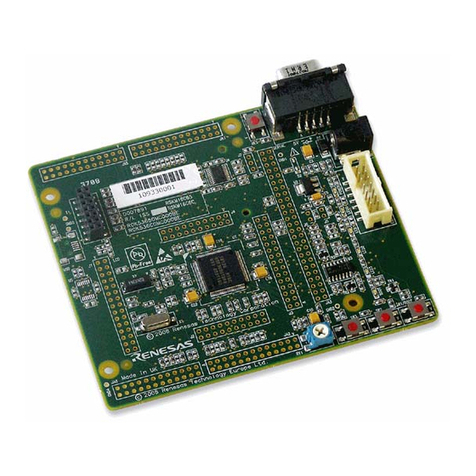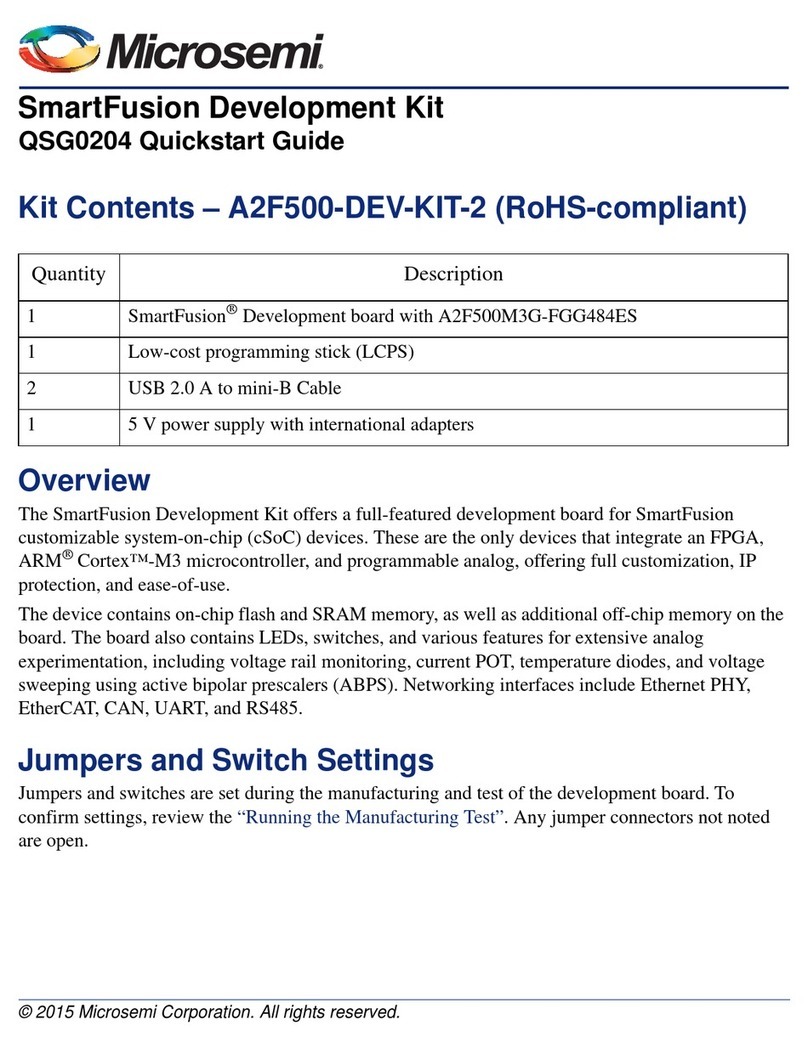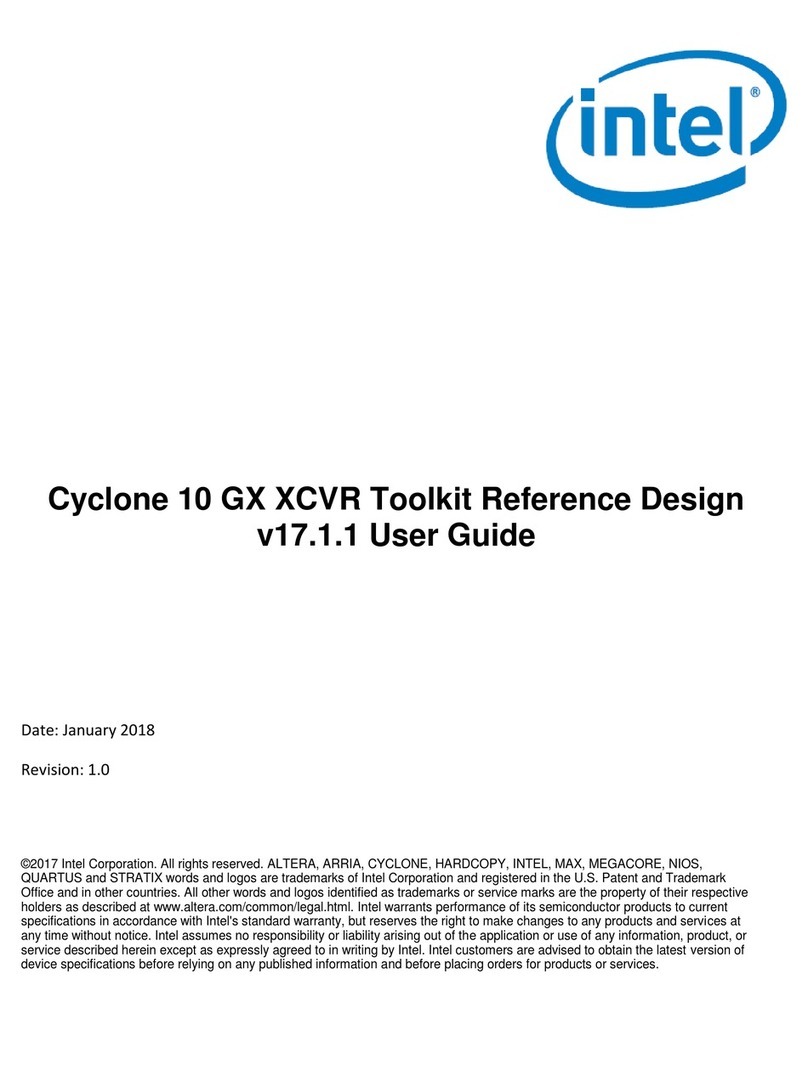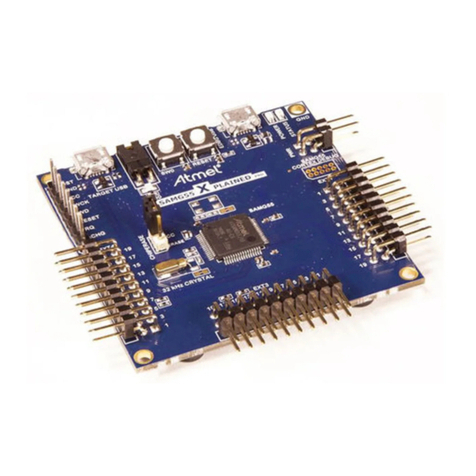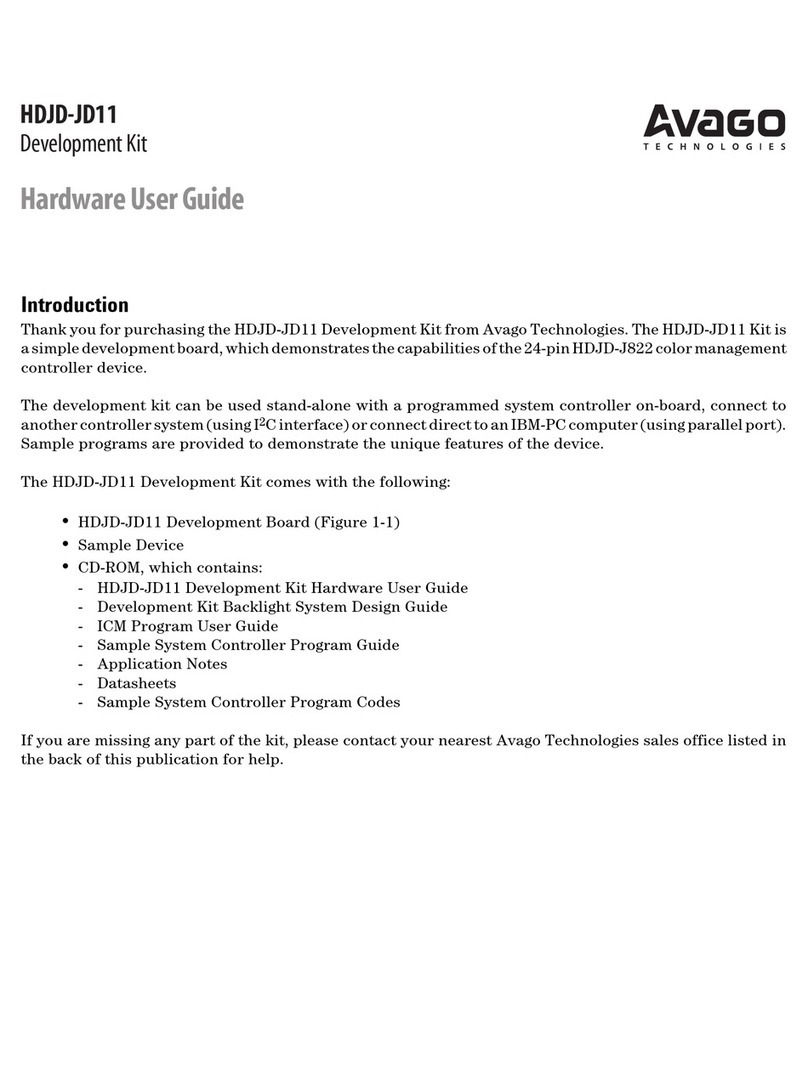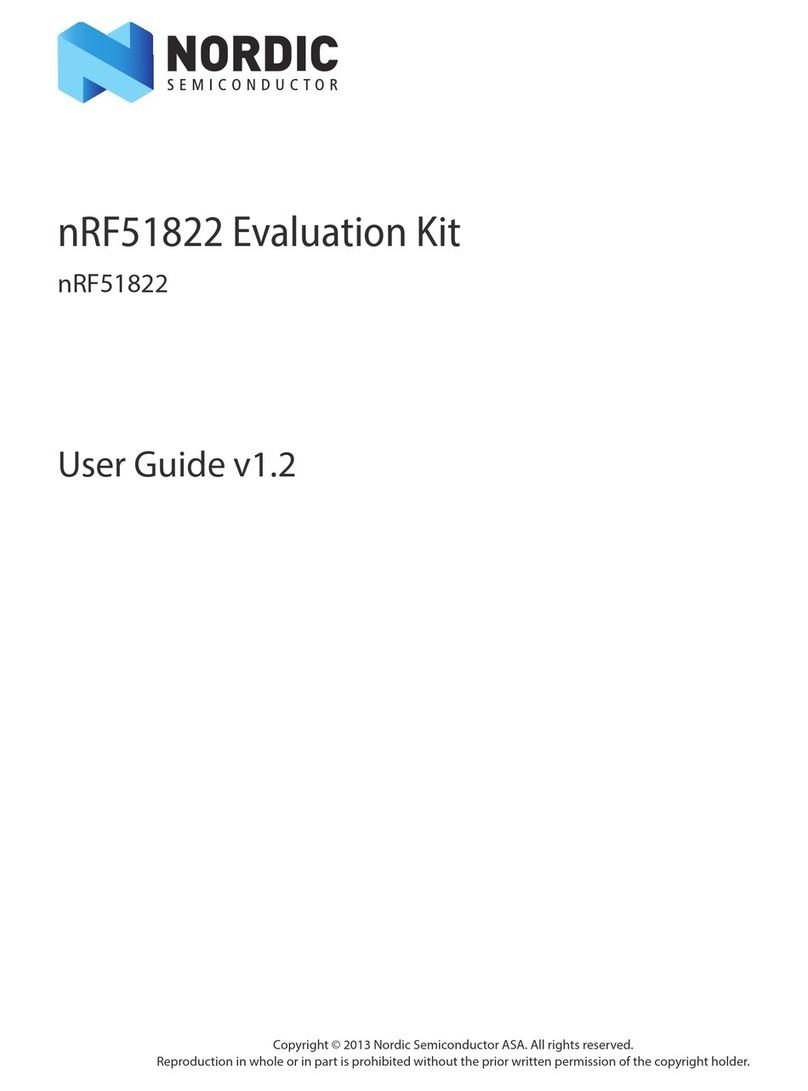hilscher netX 90 Use and care manual

Technical data reference guide
netX 90
Mass production
Hilscher Gesellschaft für Systemautomation mbH
www.hilscher.com
DOC160609TRG02EN | Revision 2 | English | 2018-09 | Preliminary | Public

Introduction 2/227
netX 90 | Technical data reference guide
DOC160609TRG02EN | Revision 2 | English | 2018-09 | Preliminary | Public © Hilscher, 2017-2018
Table of contents
1Introduction.............................................................................................................................................5
1.1 About this document ......................................................................................................................5
1.2 List of revisions...............................................................................................................................5
1.3 References to documents..............................................................................................................5
2General description and features .........................................................................................................6
2.1 Block diagram.................................................................................................................................8
2.2 Technical data netX 90 ..................................................................................................................9
2.3 netX 90 signal description............................................................................................................11
3Core .......................................................................................................................................................16
3.1 CPU..............................................................................................................................................16
3.1.1 Cortex®-M4 CPU ............................................................................................................................ 16
3.1.2 xPIC CPU........................................................................................................................................ 16
3.2 DMAC...........................................................................................................................................17
3.2.1 Overview ......................................................................................................................................... 17
3.2.2 Features.......................................................................................................................................... 18
3.2.3 Typical applications......................................................................................................................... 18
3.2.4 Functional description...................................................................................................................... 19
3.2.5 Data transfer.................................................................................................................................... 20
3.2.6 DMA channel priority....................................................................................................................... 21
3.2.7 DMA flow control............................................................................................................................. 21
3.3 Crypto core...................................................................................................................................21
3.4 Memory map ................................................................................................................................22
3.5 Brown-Out Detector (BOD)..........................................................................................................23
3.6 Power-on reset and DC/DC .........................................................................................................24
3.7 System clock (oscillator) ..............................................................................................................25
3.8 Temperature sensor.....................................................................................................................25
3.9 Interrupt vectors ...........................................................................................................................26
3.10 Timer ............................................................................................................................................28
3.10.1 CPU timer........................................................................................................................................ 28
3.10.2 IEEE 1588 system time................................................................................................................... 29
3.11 Watchdog.....................................................................................................................................30
3.11.1 Function........................................................................................................................................... 30
3.11.2 WDG_ACT signal............................................................................................................................ 30
3.12 Internal memory...........................................................................................................................31
3.12.1 Internal Flash................................................................................................................................... 31
3.12.2 Internal RAM ................................................................................................................................... 31
3.13 External memory..........................................................................................................................32
3.13.1 Overview ......................................................................................................................................... 32
3.13.2 Features.......................................................................................................................................... 33
3.13.3 SDRAM interface............................................................................................................................. 34
3.13.4 SRAM/Flash interface to memory interface controller ..................................................................... 46
4Booting and SYS LED..........................................................................................................................57
4.1 Boot sequence .............................................................................................................................57
4.2 Alternative boot mode..................................................................................................................59
4.3 System LED .................................................................................................................................59
5Interfaces...............................................................................................................................................60
5.1 MMIO - Multiplex Matrix ...............................................................................................................60
5.2 Host interface...............................................................................................................................62
5.2.1 Overview ......................................................................................................................................... 62
5.2.2 Block diagram.................................................................................................................................. 62
5.2.3 Features.......................................................................................................................................... 63
5.2.4 Dual-port memory interface structure.............................................................................................. 64
5.2.5 Parallel dual-port memory interface................................................................................................. 65
5.2.6 Serial dual-port memory interface ................................................................................................... 78
5.2.7 Handshake registers........................................................................................................................ 85
5.2.8 Parallel dual-port memory timing..................................................................................................... 88
5.2.9 Serial dual-port memory timing...................................................................................................... 118
5.3 SQI/SPI ......................................................................................................................................127
5.3.1 Overview ....................................................................................................................................... 127
5.3.2 SQI................................................................................................................................................ 129

Introduction 3/227
netX 90 | Technical data reference guide
DOC160609TRG02EN | Revision 2 | English | 2018-09 | Preliminary | Public © Hilscher, 2017-2018
5.3.3 SPI0…2_APP and SPI_XPIC_APP............................................................................................... 146
5.3.4 SQI0…1......................................................................................................................................... 151
5.4 I2C..............................................................................................................................................152
5.4.1 Overview ....................................................................................................................................... 152
5.4.2 Block diagram................................................................................................................................ 153
5.4.3 Features........................................................................................................................................ 154
5.4.4 Typical applications....................................................................................................................... 154
5.4.5 Functional description.................................................................................................................... 154
5.4.6 I2C devices.................................................................................................................................... 154
5.4.7 I2C signals..................................................................................................................................... 154
5.4.8 I2C signal conditions ..................................................................................................................... 155
5.4.9 I2C transfers.................................................................................................................................. 155
5.4.10 I2C acknowledge handling ............................................................................................................ 156
5.4.11 I2C 10-bit addressing .................................................................................................................... 156
5.4.12 I2C general call ............................................................................................................................. 157
5.4.13 I2C cycle stretching....................................................................................................................... 157
5.4.14 I/O timing....................................................................................................................................... 158
5.5 Multi LED....................................................................................................................................159
5.5.1 Overview ....................................................................................................................................... 159
5.5.2 Features........................................................................................................................................ 159
5.5.3 Typical applications....................................................................................................................... 160
5.5.4 Functional description.................................................................................................................... 160
5.5.5 Time-multiplexed PWM mode ....................................................................................................... 161
5.5.6 Pass-through mode....................................................................................................................... 162
5.5.7 Features for both modes ............................................................................................................... 162
5.6 GPIO ..........................................................................................................................................163
5.6.1 Overview ....................................................................................................................................... 163
5.6.2 Features........................................................................................................................................ 165
5.6.3 Typical applications....................................................................................................................... 166
5.6.4 Functional description.................................................................................................................... 166
5.6.5 Simple read/write modes............................................................................................................... 166
5.6.6 Counter as system timer................................................................................................................ 167
5.6.7 Event time capture......................................................................................................................... 167
5.6.8 Event counting............................................................................................................................... 169
5.6.9 Active time measurement.............................................................................................................. 170
5.6.10 Watchdog mode............................................................................................................................ 170
5.6.11 Standard PWM.............................................................................................................................. 171
5.6.12 PWM with shadow registers.......................................................................................................... 171
5.6.13 DC-DC PWM................................................................................................................................. 173
5.6.14 Sequencer..................................................................................................................................... 174
5.6.15 Sharing between different CPUs................................................................................................... 175
5.6.16 Interrupt handling .......................................................................................................................... 175
5.6.17 I/O timing....................................................................................................................................... 176
5.7 PIO (application) ........................................................................................................................177
5.8 BiSS/SSi.....................................................................................................................................178
5.8.1 Overview ....................................................................................................................................... 178
5.8.2 Functional description.................................................................................................................... 178
5.8.3 Trigger sources ............................................................................................................................. 179
5.8.4 Interrupt logic................................................................................................................................. 179
5.9 EnDat .........................................................................................................................................180
5.9.1 Overview ....................................................................................................................................... 180
5.9.2 Functional description.................................................................................................................... 180
5.9.3 Trigger sources ............................................................................................................................. 181
5.9.4 Edge detector and pulse former.................................................................................................... 181
5.10 CAN controller............................................................................................................................182
5.10.1 Features........................................................................................................................................ 182
5.11 UART..........................................................................................................................................183
5.12 IO-Link controller........................................................................................................................186
5.12.1 Introduction.................................................................................................................................... 186
5.12.2 Typical application......................................................................................................................... 187
5.13 ADC............................................................................................................................................188
5.14 LVDS..........................................................................................................................................189
5.15 Motion PWM...............................................................................................................................190
5.16 Quadrature decoder...................................................................................................................190
5.17 Ethernet interface.......................................................................................................................191
5.18 Fieldbus interface.......................................................................................................................193
6Debugging...........................................................................................................................................194

Introduction 4/227
netX 90 | Technical data reference guide
DOC160609TRG02EN | Revision 2 | English | 2018-09 | Preliminary | Public © Hilscher, 2017-2018
7Electrical specification ......................................................................................................................194
7.1 Absolute max. ratings.................................................................................................................195
7.2 Power-up and down sequencing................................................................................................195
7.3 Power consumption / Power dissipation....................................................................................195
7.3.1 Power consumption of netX 90...................................................................................................... 195
7.4 AC/DC specifications .................................................................................................................195
7.4.1 Oscillator ....................................................................................................................................... 196
7.4.2 Power-on reset and DC/DC........................................................................................................... 196
7.4.3 BOD............................................................................................................................................... 197
7.4.4 ADC............................................................................................................................................... 197
7.5 Failure rate (FIT)........................................................................................................................197
8netX 90 package and signal information .........................................................................................198
8.1 Pin table sorted by signals .........................................................................................................198
8.2 Pin table sorted by pin number ..................................................................................................204
8.3 Pin overview netX 90 .................................................................................................................210
8.4 PAD type explanation.................................................................................................................212
8.5 Schematic view of netX 90 PAD types.......................................................................................213
8.6 netX 90 package ........................................................................................................................214
8.7 Thermal resistance.....................................................................................................................216
8.8 Moisture sensitivity level ............................................................................................................216
9Appendix .............................................................................................................................................217
9.1 Terms, abbreviations, and definitions ........................................................................................217
9.2 Legal notes.................................................................................................................................219
9.3 Registered trademarks...............................................................................................................222
9.4 List of tables...............................................................................................................................223
9.5 List of figures..............................................................................................................................224
9.6 Contacts .....................................................................................................................................227

Introduction 5/227
netX 90 | Technical data reference guide
DOC160609TRG02EN | Revision 2 | English | 2018-09 | Preliminary | Public © Hilscher, 2017-2018
1 Introduction
1.1 About this document
This document describes the netX 90 chip functions.
1.2 List of revisions
Rev Date Name Chapter Revision
1 2017-06-27 HN all Preliminary.
2 2018-09-13 HN, NM,
HH all Completely revised.
Table 1: List of revisions
1.3 References to documents
This document refers to the following documents:
[1] Hilscher Gesellschaft für Systemautomation mbH: regdef_netx90_arm_app.html, Englisch,
2018.
[2] Hilscher Gesellschaft für Systemautomation mbH: Design-In Guide, netX 90, Revision 2,
English, 2018.
[3] Hilscher Gesellschaft für Systemautomation mbH: Getting started, netX Studio CDT, netX 90
development, Revision 4, English, 2018.
[4] Hilscher Gesellschaft für Systemautomation mbH: Programming Reference Guide, xPIC
Instruction Set, netX 6/10/51/52, Revision 1, English, 2015.
[5] ARM: ARMv7-M Architecture Reference Manual, ARM DDI0403E.B, English, 2014.
Download: http://infocenter.arm.com/help/index.jsp
[6] Philips Semiconductors: The I2C-Bus Specification, version 2.1, 01.2000, English.
[7] iC-Haus GmbH: http://www.biss-interface.com/
[8] ams Sensors Germany GmbH: http://www.mazet.de/en/products/industrial-metrology/data-
sheets/item/445-endat-2-2-master-basic.html
Table 2: References to documents

General description and features 6/227
netX 90 | Technical data reference guide
DOC160609TRG02EN | Revision 2 | English | 2018-09 | Preliminary | Public © Hilscher, 2017-2018
2 General description and features
The netX 90 is a highly integrated Industrial Ethernet node in a 10x10 mm2, 144-pin BGA footprint
with two ARM® Cortex®-M4 cores, on-chip Flash memory, Fast Ethernet PHYs, DC/DC converter,
POR circuit, and a feature-rich set of on-chip peripherals.
The industrial communication SoC fulfils the highest demand on flexibility, determinism and
performance in terms of multiprotocol capability and low latency for short cycle times. As a result,
the netX 90 provides a superior solution with an unmatched protocol flexibility for a variety of
industrial slave or device applications in the process and factory automation.
Enhanced multiprotocol capability
The SoC features two flexible communication (xC) IPs, which support all popular Industrial
Ethernet standards, i.e. hard real-time. Most importantly, the xC architecture flexibly adapts by
software to emerging standards and future network requirements such as TSN.
Two separate system paradigms
One highlight of the chip’s internal architecture is the logical separation of the communication tasks
and the application tasks, both from software quality and security aspects. The partitioning restricts
the software access to on-chip peripherals on either side.
Built-in security and diagnostics
Built-in security features enable developers to apply a secure by design concept by building layers
of security as outlined in the IEC 62443, coupled with built-in diagnostics to monitor operating
conditions for IIoT-enabled cloud services, e.g. predictive maintenance.
Prebuilt communication firmware
Software protocol stacks for communication tasks come as prebuilt firmware, i.e. tested and pre-
certified by Hilscher. The data exchange with the protocol stack interface using the dual-ported
memory (DPM) enables application developers to quickly set up a network prototype.
Two primary design-in uses cases
Suitable for modular embedded designs as companion chip with host interface that easily pairs
with custom-specific host application processors. The host interface ensures a high degree of
interoperability for maximum data throughput as either parallel or serial interfaces.
Suitable for standalone chip application designs that make use of the second Cortex®-M4 at 100
MHz with DSP and FPU support, enhanced by a feature-rich set of standard and industry-related
peripheral units with connectivity for highly compact product application designs.

General description and features 7/227
netX 90 | Technical data reference guide
DOC160609TRG02EN | Revision 2 | English | 2018-09 | Preliminary | Public © Hilscher, 2017-2018
netX 90 at a glance
Best-in class real-time
Supports PROFINET IO Device V2.3 with
Fast startup (FSU),
Dynamic Frame Packing (DFP), and
Fast-Forwarding (FFWD)
Scalable SoC platform
Standalone chip application or companion chip with host interface
Multiprotocol capability
Supports all popular Industrial Ethernet and Fieldbus standards
Embedded application
Feature-rich set of standard and industry-related peripheral units
Industrial IoT ready
Built-in security and diagnostic features for IIoT enabled services
Energy-efficient SoC
Suitable for product application designs with smallest form factors
Application examples
Multiprotocol chip interface for motion control
Black channel communication for functional safety
Variety of sensors and actuators for industrial control
Gateway interface or adapter module for universal encoders
LVDSPHY based low-cost backplane bus for industrial protocols
Remote I/O with multichannel IO-Link or as analog/digital I/O blocks
Suitable for any type of slave or device applications that require Industrial Ethernet or Fieldbus
connectivity such as instrumentations, pneumatics, gateways, and many more.

General description and features 8/227
netX 90 | Technical data reference guide
DOC160609TRG02EN | Revision 2 | English | 2018-09 | Preliminary | Public © Hilscher, 2017-2018
2.1 Block diagram
Cortex M4
Subsystem
ARM App
Intlogic App
Intlogic Com
Crypt System
Communication Side Dataswitch
No access from application side except via IDPM.
Access to App side possible for debug and secure boot.
For accessibility view netxtiny_master_slaves interconnection Excel sheet
Cortex M4
Subsystem
ARM Com
4x 8kB pRAM
2x 8kB dRAM
2ch Ethernet PHY
INTRAM0 128kB
INTRAM1 128kB
INTRAM3 64kB
INTRAM4 64kB
INTRAMHS 32kB
Dual Handshake Cells
AHB Master Channels
AHB Slave Channels
BootROM 128kB
SWD
SPM1
acyclic
DPM0/DPM1/IDPM cfg
MEM8
DPM HostCPU16
or
Peripherals:
1x I2C
1x UART
3x SPI
2x SQI
2x CAN
29x PIO
Com ARM
xC01
Framebuffer
xPIC Com System
2x PHY-Ctrl
Peripherals:
2x I2C
RDY/RUN
Reset-Out
1x UART
1x SPI
xC Config
Pointer FIFO
xC BufMan
Trig/Sample
FMMUSM
xPIC App System
DS D IS
xPIC Com
Subsystem
8kB dRAM
8kB pRAM
Systime LT
Timer
WDG
CPU-Ping
DI
INTRAM2 128kB
INTRAM6 32kB App ARM
INTRAM7 32kB App xPIC
Com xPIC INTRAM5 32kB
DPM0/
SPM0
general or
fast cyclic
EA data
Win
SDRAM
Multimaster
1CS x
256MB
Flash/NVRAM
3CS x 32MB
ExtBus8/16
Shared Dataswitch
Cfg Channels (APB)
Win
HIF
SPM0
SPM0
MEM16
18 MMIO
SPM1 or
or
or
or
INTFLASH0 512kB
Motion:
2x BISS/SSI
2x EnDAT
M-PWM
M-Encoder
BOD BOD Stat
ETH
MAC
MII2
LVDS CTRL
LVDS-MII tunnels
2xMII+MDIO or 2xFieldbus
boot
App ARM
Start (reset
release) from
Com-Side (global
NETX Ctrl)
INTRAM, INTFLASH:
BIST, ECC(2bit detect, 1bit cor.)
LX
VDD3.3
VDDcore
ECC status
Clock
Supervisor
INTFLASH1 512kB
INTRAM, INTFLASH:
BIST, ECC(2bit detect, 1bit cor.)
DC/DC
VDD3.3
->
VDDcore
SQI eXecute in Place
1CS x 64MB
1x I2C
8x IO-Link
xPIC App
Subsystem
8kB dRAM
8kB pRAM
VIC
Timer
WDG
CPU-Ping
cfg DI
cfg
DIS
DMAC
(4 ch)
DMAC
(4 ch)
CoreSight, ETM
NVIC
MPU NVIC
MPU
FPU
Debug Master
Analog Macros
Peripherals (int, ext)
System Slaves/Dataswitch
System Master
Memory (SRAM, read-only, ext.)
boot Com ARM
Win
IDPM
Slave
SHA1 (160)
SHA2(256,284,512)
AES(128,192,256)
MD5
RSA / ECC (MTGY)
xC01
Subsystem
xMAC
tPEC
rPEC
xMAC
tPEC
rPEC
xC Systime VIC
Systime LT
Watchdog
Timer, 2x Systime
Systime LT
CPU-Ping
Watchdog
Timer, Systime
Systime LT
CPU-Ping
xC Bridge
DPM Tripple
Buffer
Win
Application Side Dataswitch
Access from communication side possible for debug
and secure boot.
Access to Com-side only via IDPM.
For accessibility view netxtiny_master_slaves
interconnection Excel sheet.
GPIO xPIC App port
trace
Boundary Scan
SWD/JTAG
Wdg-active
Reset Ctrl
RstIn_n
PwrOnRst
8x Com-LEDs
OSC(2.5MHz)
external
crystal
(25MHz)
PLL(400MHz)
Memory BIST
INTFLASH2 512kB
4x Multi-LED Ctrl
MLED0..3
16x App-LEDs
8x Multi-LED Ctrl
MLED4..11
4x GPIO
1x Timer
PWM
Capture
Event
Stream
Blink
GPIO ARM App port
8x GPIO
3x Timer
PWM
Capture
Event
Stream
Blink
Slaves/Memories: Access from both
sides, Com has higher priority
Master: Access to both sides
cfg cfg
Intlogic Shared
Global NETX Ctrl
cfg of external memories
IO-cfg (MUX, physical)
SPI/SQI (XiP cfg/prog)
M-ADC
CTRL
4x ADC
12bit SAR,
1MS/s
Ain MUX
20x Ain
(2+2+8+8)
Temp.
VDD
4x SH
INTFLASH0/1 (cfg/prog)
INTFLASH2 (cfg/prog)
nFIFO
gBufMan
ECC status
CRC
M
Debug Slave
MMIO cfg
UART
Figure 1: Block diagram

General description and features 9/227
netX 90 | Technical data reference guide
DOC160609TRG02EN | Revision 2 | English | 2018-09 | Preliminary | Public © Hilscher, 2017-2018
2.2 Technical data netX 90
Category Features Communication Application
Core ARM® Processor Cortex®-M4 at 100 MHz with MPU Cortex®-M4 at 100 MHz with MPU and
FPU
Hilscher 32-bit RISC 1 x xPIC at 100 MHz 1 x xPIC at 100 MHz
Tightly-coupled memory 1 x D-TCM, 8 KB, 1 x I-TCM, 8 KB 1 x D-TCM, 8 KB, 1 x I-TCM, 8 KB
Memory SRAM (ECC) 576 KB 64 KB
Flash (ECC) 1024 KB 512 KB
Mask ROM 128 KB -
System DMA controller 4 channels 4 channels
WDC (ARM / xPIC) 1 / 1 1 / 1
Timer (ARM / xPIC) 3x 32-bit / 3x 32-bit 3x 32-bit / 3x 32-bit
Built-in bootloader Host Interface (DPM/SPM), Ethernet (xC0 DHCP/TFTP), Serial (FTDI USB to
JTAG/UART)
Network xC Subsystem 2 channels -
IEEE 1588 SysTime 2 1
Fast Ethernet PHY Dual-port, FX support -
100 Mbps LVDSPHY Dual-port -
Ethernet MAC Ethernet MAC 10 / 100 Mbps, MII
Peripheral UART (up to 6.25 Mbaud) 1 (shared) 3
SPI (up to 50 MHz) - 4
SQI (up to 50 MHz) 2 (Master only, with SPI mode)
I2C (up to 3.4 MHz) 2 2
CAN 2.0B (up to 1 Mbps) - 2
IO-Link V1.1 controller - 8 channels
MLED (PWM tuned) 4 8
HIF PIO / PIO / GPIO / MMIO - / - / 4 / - up to 41 / 29 / 8 / 18
Mixed signal Timer (PWM, IC/OC) 4x 32-bit (min. 10 ns) 8x 32-bit (min. 10 ns)
Motion PWM unit - 1
ADC SAR (12-bit, 2 Msps) 2x 2 channels and 2x 8 channels
Quadrature decoder - 2
EnDat 2.2 (Master E6) - 2 (with RTM)
BiSS / SSI (Master BiSS C) - 2 / 2
Host interface Parallel (DPM) 8/16-bit (Read access min. 55 ns) Internal 32-bit
Serial (SPM) 2x SPI (up to 125 MHz) /
QSPI (up to 33 MHz) -
MAC (PHY mode) MII (10/100 Mbps) -
External
memory SRAM / NOR / NAND /
SDRAM ✓/ ✓/ - / ✓(8/16-bit)
SD/MMC / SDIO SPI mode / -
SQI (XiP) ✓
Security Crypto core SSL/TLS accelerator, up to RSA-4096, ECC-512, AES-256, and SHA-512
Secure boot Mask ROM code, EMSA-PSS
Built-in support Security levels, AHB Firewall
Debug Debug / Trace JTAG/SWD, 4-bit TPIU
Boundary scan JTAG

General description and features 10/227
netX 90 | Technical data reference guide
DOC160609TRG02EN | Revision 2 | English | 2018-09 | Preliminary | Public © Hilscher, 2017-2018
Category Features Communication Application
Analog DC/DC / POR / BOD ✓/ ✓/ ✓
Thermal diode ✓
Clock supervisor Xtal (RC-Osc)
Electrical Power supply Single 3.3V
Temperature range Ta-40°C ... +85°C
Power consumption TBD (≤1 W)
Package dimension 144-pin BGA, 10x10 mm2, 0.8 mm Ball Pitch
Table 3: Technical data

General description and features 11/227
netX 90 | Technical data reference guide
DOC160609TRG02EN | Revision 2 | English | 2018-09 | Preliminary | Public © Hilscher, 2017-2018
2.3 netX 90 signal description
This list groups the signals of the pin assignment table with the multiplexed signals (“shared with”
operating modes), see chapter netX 90 package and signal information on page 198.
General
RST_IN_N Reset input
RDY_N Ready (RDY-LED/Console mode)
RUN_N Run (RUN-LED/Alternative boot mode)
MLED0…3 Multi-LED/Status LEDs COM0/1
COM_IO0…3 Communication input output/peripherals
Power
VDDC Power supply voltage, core
VDDIO Power supply voltage, input output
VSS (GND) Ground
PHY_VDDC Internal PHY, power supply, core
PHY_VDDIO
Internal PHY, power supply, input output
VDD_PLL Power supply voltage, core - phase lock loop
Misc Analog
OSC_XTI (XTALIN) 25 MHz Crystal input
OSC_XTO (XTALOUT) 25 MHz Crystal output
DCDC_LX_OUT DCDC output inductor
VSS_REF Ground, reference voltage
VREF_ADC Reference voltage, analog-to-digital converter
BOD Brown-out detection
MII – Media-Independent Interface (External Ethernet PHY)
MII_MDC Ethernet MAC management data clock
MII_MDIO Ethernet MAC management data input output
MII0+1_RXCLK Ethernet MAC receive clock
MII0+1_RXD0…3 Ethernet MAC receive data 0...3
MII0+1_RXDV Ethernet MAC receive data valid
MII0+1_RXER Ethernet MAC receive error
MII0+1_TXCLK Ethernet MAC transmit clock
MII0+1_TXD0…3 Ethernet MAC transmit data 0...3
MII0+1_TXEN Ethernet MAC transmit enable
MII0+1_TXER Ethernet MAC transmit error
MII0+1_COL
Ethernet MAC collision
MII0+1_CRS Ethernet MAC carrier sense
PHY0+1_LED_LINK_IN Ethernet PHY Link LED input
RST_OUT_N Reset output
CLK25OUT Clock 25 output
LVDS (Integrated dual LVDSPHY)
LVDS0+1_RXN LVDSPHY, receive input negative
LVDS0+1_RXP LVDSPHY, receive input positive
LVDS0+1_TXN LVDSPHY, transmit output negative
LVDS0+1_TXP LVDSPHY, transmit output positive

General description and features 12/227
netX 90 | Technical data reference guide
DOC160609TRG02EN | Revision 2 | English | 2018-09 | Preliminary | Public © Hilscher, 2017-2018
PHY (Integrated dual Ethernet PHY)
PHY_EXTRES Ethernet PHY, reference resistor
PHY0+1_RXN Ethernet PHY, receive input negative
PHY0+1_RXP Ethernet PHY, receive input positive
PHY0+1_TXN
Ethernet PHY, transmit output negative
PHY0+1_TXP Ethernet PHY, transmit output positive
FO (Fiber optic)
FO0+1_RX Ethernet PHY, fiber optic receive data
FO0+1_SD Ethernet PHY, fiber optic signal detect
FO0+1_TX Ethernet PHY, fiber optic transmit data
FO0+1_EN_TX Ethernet PHY, fiber optic enable control
MMIO
MMIO0…17 Multiplex matrix I/O 0...17
PIO_APP
PIO_APP0…28 Programmable Input/Output, Application side
MENC
MENC_MP0+1 Motion encoder MP
MENC0+1_A Motion encoder, input A
MENC0+1_B Motion encoder, input B
MENC0+1_N Motion encoder, input index
MPWM
MPWM_BRAKE Motion Pulse Width Modulation, Brake
MPWM_FAIL Motion Pulse Width Modulation, Fail
MPWM0…5 Motion Pulse Width Modulation 0…5
HIF (8-bit or 16-bit DPM interface)
HIF_A0...17 Host interface address lines 0…17
HIF_BHEN Host interface, byte high enable
HIF_CSN Host interface, chip select
HIF_D0...15 Host interface data lines 0…15
HIF_DIRQ Host interface, data interrupt request
HIF_RDN Host interface, read
HIF_RDY Host interface, ready
HIF_SDCLK Host interface, serial data clock
HIF_SIRQ Host interface, synchron interrupt request
HIF_WRN Host interface, write
DEBUG
JT_TCK JTAG test clock
JT_TMS JTAG test mode select
JT_TDI JTAG test data input
JT_TDO JTAG test data output
JT_TRST JTAG test reset
SWDCLK Serial Wire Debug clock
SWDIO Serial Wire Debug data input output
TRACE_DATA0…3 Trace port data
TRACECLK
Trace port clock
TRACECTL Trace port control

General description and features 13/227
netX 90 | Technical data reference guide
DOC160609TRG02EN | Revision 2 | English | 2018-09 | Preliminary | Public © Hilscher, 2017-2018
EXT (Extension bus/memory interface)
EXT_A0…17 Extension bus address lines 0…17
EXT_BHEN Extension bus byte high enable
EXT_CS0…2N Extension bus chip select 0…2
EXT_D0…15
Extension bus data lines 0…15
EXT_RDN Extension bus read enable
EXT_RDY Extension bus ready
EXT_WRN Extension bus write enable
IO_LINK (Controller interface)
IO_LINK0…7_IN IO-Link 0…7 input
IO_LINK0…7_OE IO-Link 0…7 output enable
IO_LINK0…7_OUT
IO-Link 0…7 output
IO_LINK0…7_WAKEUP IO-Link 0…7 wake up
SDRAM (Synchronous Dynamic Random Access Memory interface)
SD_A0…12 SDRAM address lines 0…12
SD_BA0 SDRAM bank address 0
SD_BA1 SDRAM bank address 1
SD_CASN SDRAM column address strobe
SD_CKE SDRAM clock enable
SD_CLK SDRAM clock
SD_CSN SDRAM chip select
SD_D0…15 SDRAM data lines 0…15
SD_DQM0+1 SDRAM data qualifier mask 0+1
SD_RASN SDRAM row address strobe
SD_WEN SDRAM write enable
XM (Fieldbus interface)
FB0+1CLK Fieldbus clock
XM0+1_ECLK XMAC fieldbus, external clock
XM0+1_IO0…5 XMAC fieldbus, input output 0…5
XM0+1_RX XMAC fieldbus, receive
XM0+1_TX XMAC fieldbus, transmit
XM0+1_TXOE
XMAC fieldbus, transmit output enable
XM0+1_TX_ECLK XMAC fieldbus, transmit external clock
XM0+1_TXOE_ECLK XMAC fieldbus, transmit output enable, external clock
GPIO
GPIO0…7 and 8…11 General purpose input/output 0…7 application and 8…11 communication
SPM (Serial DPM interface)
DPM0+1_SPI_CLK Serial DPM (SPI, SQI), clock
DPM0+1_SPI_CSN Serial DPM (SPI, SQI), chip select
DPM0+1_SPI_DIRQ Serial DPM (SPI, SQI), data interrupt request
DPM0+1_SPI_MISO Serial DPM (SPI), master in / slave out;
Serial DPM (SQI), serial input/output data 1
DPM0+1_SPI_MOSI Serial DPM (SPI), master out / slave in;
Serial DPM (SQI), serial input/output data 0
DPM0+1_SPI_SIRQ
Serial DPM (SPI, SQI), synchron interrupt request
DPM0+1_SQI_SIO2+3 Serial DPM (SQI), serial input/output data 2+3

General description and features 14/227
netX 90 | Technical data reference guide
DOC160609TRG02EN | Revision 2 | English | 2018-09 | Preliminary | Public © Hilscher, 2017-2018
UART (Universal Asynchronous Receiver/Transmitter)
UART_APP_CTSN UART, application, clear to send
UART_APP_RTSN UART, application, request to send
UART_APP_RXD UART, application, receive data
UART_APP_TXD UART, application, transmit data
UART_CTSN UART, clear to send
UART_RTSN UART, request to send
UART_RXD UART, receive data
UART_TXD UART, transmit data
UART_XPIC_APP_CTSN UART, xPIC application, clear to send
UART_XPIC_APP_RTSN UART, xPIC application, request to send
UART_XPIC_APP_RXD
UART, xPIC application, receive data
UART_XPIC_APP_TXD UART, xPIC application, transmit data
SQI (Serial Quad I/O) / XiP (Serial flash memory interface)
SQI_CLK SQI, clock signal
SQI_CS0..2N SQI, chip select signal, negated
SQI_MOSI SQI, master in / slave out (serial input/output data 0)
SQI_MISO SQI, master out / slave in (serial input/output data 1)
SQI_SIO2+3 SQI, serial input/output data 2+3
SPI (Serial Peripheral Interface)
SPI0_APP_CS0+1N SPI, application, chip select signal, negated
SPI0…2_APP_CLK SPI, application, clock signal
SPI0…2_APP_MISO SPI, application, master in / slave out
SPI0…2_APP_MOSI SPI, application, master out / slave in
SPI1+2_APP_CS0…2N SPI, application, chip select, negated
SPI_XPIC_APP_CLK SPI, xPIC application, clock signal
SPI_XPIC_APP_CS0…2 SPI, xPIC application, chip select
SPI_XPIC_APP_MISO SPI, xPIC application, master in / slave out
SPI_XPIC_APP_MOSI SPI, xPIC application, master out / slave in
SQI (Serial Quad I/O)
SQI0_APP_CS1…2N SQI, application, chip select signal, negated
SQI0+1_APP_CLK (_B) SQI, application, clock signal (B = alternative)
SQI0+1_APP_CS0N (_B) SQI, application, chip select signal, negated, (B = alternative)
SQI0+1_APP_MISO (_B) SQI, application, master in / slave out (serial input/output data 1) (B = alternative)
SQI0+1_APP_MOSI (_B) SQI, application, master out / slave in (serial input/output data 0) (B = alternative)
SQI0+1_APP_SIO2+3 (_B) SQI, application, serial input/output data 2+3 (B = alternative)
MLED
MLED0…11 Multi Light Emitting Diode 0…3 communication; 4...11 application
ENDAT (Master 2.2)
ENDAT0+1_CLK Encoder Data clock output
ENDAT0+1_IN Encoder Data data input
ENDAT0+1_OE Encoder Data output enable
ENDAT0+1_OUT Encoder Data data output

General description and features 15/227
netX 90 | Technical data reference guide
DOC160609TRG02EN | Revision 2 | English | 2018-09 | Preliminary | Public © Hilscher, 2017-2018
I2C
I2C_APP_SCL I2C, application, clock signal
I2C_APP_SDA I2C, application, data signal
I2C_XPIC_APP_SCL I2C, xPIC application, clock signal
I2C_XPIC_APP_SDA I2C, xPIC application, data signal
I2C0+1_COM_SCL I2C, communication, clock signal
I2C0+1_COM_SDA I2C, communication, data signal
BISS (Master BiSS C)
BISS0+1_MA Bidirectional/Serial/Synchronous clock output
BISS0+1_MO Bidirectional/Serial/Synchronous data output
BISS0+1_SL Bidirectional/Serial/Synchronous data input
ADC
ADC0+1_IN0+1 Analog-to-digital converter input 0+1
ADC2+3_IN0…7 Analog-to-digital converter input 0…7
CAN
CAN0+1_APP_RX CAN, application, receive data
CAN0+1_APP_TX CAN, application, transmit data
XC
XC_TRIGGER0…1 RTE synchronization signals
Table 4: netX 90 signal description

Core 16/227
netX 90 | Technical data reference guide
DOC160609TRG02EN | Revision 2 | English | 2018-09 | Preliminary | Public © Hilscher, 2017-2018
3 Core
3.1 CPU
3.1.1 Cortex®-M4 CPU
The application part of the chip features a high-performance ARM® Cortex®-M4 processor core:
ARMv7ME Architecture
Thumb-2 Technology
125 DMIPS
3-stage pipeline
Integrated NVIC and MPU
Integrated DSP and SIMD instructions
Single cycle MAC
Single precision FPU
Documentation about Cortex®-M4, see reference [5].
3.1.2 xPIC CPU
The xPIC (fleXible Peripheral Interface Controller) is a 32-bit RISC CPU from Hilscher optimized
for fast and deterministic data processing. For instruction set, see reference [4].
The xPIC is used as peripheral controller for interfaces such as IO-Link, Ethernet MAC, etc. for
which Hilscher provides low-level software drivers as HAL (Hardware Abstraction Layer) for the
Cortex®-M4.
The real-time capability of the xPIC enables Hilscher to program code-optimized, custom-specific
features that are not supported by standard peripheral units. Therefore, the xPIC has a dedicated
internal peripheral bus to ensure a deterministic response for very time critical IO tasks. If the xPIC
is not used for the application, all on-chip peripherals connected at xPIC App System (see Figure
1) can be used by the Cortex®-M4 CPU.

Core 17/227
netX 90 | Technical data reference guide
DOC160609TRG02EN | Revision 2 | English | 2018-09 | Preliminary | Public © Hilscher, 2017-2018
3.2 DMAC
3.2.1 Overview
The DMA controller manages data transfers between DMA slaves and memory slaves without
using the ARM CPU. This allows fast data transfers that do not affect the CPU load.
A slave is a device selected by a controlling master as the source or target of a transfer.
A slave can also begin a service request using an interrupt.
The DMA controller
is functionally compatible with the ARM master DMA controller (PL081)
is designed to use only one master channel in the system
can support up to three DMA channels
Each DMA channel can be programmed for various features, e.g.:
Transfer size
Interrupt generation
Memory and I/O address space
Transfer direction
The netX 90 includes two completely independent DMA controllers: One on the com-side and one
on the app-side. Therefore, both DMACs are connected to different peripherals. Some peripherals
are connected to both DMACs because they can be operated from either side (not at the same
time, of course).
DMAC
cfg
Peripheral 0
INTRAM
Peripheral x
...
Peripheral x+1
Peripheral y
...
flow control
... ...
DMAC
cfg
Peripheral y+1
INTRAM
Peripheral z
...
flow control
DMAC_MUX
6
... ...
Com-side App-sideshared
Dataswitch Dataswitch Dataswitch
Figure 2: Simplified block diagram of the DMA controllers

Core 18/227
netX 90 | Technical data reference guide
DOC160609TRG02EN | Revision 2 | English | 2018-09 | Preliminary | Public © Hilscher, 2017-2018
3.2.2 Features
Compatible with ARM DMAC (PL081) software and register
1 AHBL master port used for DMA transfer and linked list operations
1 AHBL slave port as configuration interface
3 DMA channels with separated linked lists and configuration registers
4 FIFO elements (32-bit) per channel
Incrementing or non-incrementing addressing for source and destination
Programmable burst size.
32, 16, and 8-bit support for source and destination in all combinations
Fixed DMA channel priority:
Channel 0 has the highest priority
Channel 2 has the lowest priority
Memory-to-memory, memory-to-peripheral, peripheral-to-memory DMA transfers
DMAC or peripheral flow control
Programmable interrupt capabilities, e.g.:
error and finish interrupt generation
interrupt masking and clearing
The netX system and bus matrix implementation do not support the following DMAC features:
No AHB-protected transfers (user mode, buffer ability, cacheable)
No AHB-locked transfers
No big-endian support
No peripheral-to-peripheral DMA transfers
3.2.3 Typical applications
Optimized memory copy function
Optimized peripheral data block transfer function
Periodical data transfer to slave/master

Core 19/227
netX 90 | Technical data reference guide
DOC160609TRG02EN | Revision 2 | English | 2018-09 | Preliminary | Public © Hilscher, 2017-2018
3.2.4 Functional description
The following section provides a detailed description of the DMA controller and its features.
The 3-channel DMA controller supports the following transactions in the netX system:
Peripheral-to-memory transfer
Memory-to-peripheral transfer
Memory-to-memory transfer
The netX system and its peripherals do not support peripheral-to-peripheral transfers, but they are
configurable via the register interface.
FIFO FIFO FIFO
src addr
dest addr
linked list
control
src addr
dest addr
linked list
control
src addr
dest addr
linked list
control
Channel 0 Channel 1 Channel 2
Interrupts
Error Interrupt Terminal Count Interrupt
Interrupt
AHBL
(slave)
AHBL (master)
Flow control
interface
Mux / priority
DMA Controller
or
Figure 3: Simplified internal structure of the DMA controller
Each channel supports a unidirectional DMA transfer, up to 32 bit, for a single source and
destination address. A bidirectional transfer therefore requires one channel for transmit and one for
receive.
The source and destination address can be a memory region or a DMA-capable peripheral device
of the netX. A system master programs the DMA controller via the AHBL slave interface.

Core 20/227
netX 90 | Technical data reference guide
DOC160609TRG02EN | Revision 2 | English | 2018-09 | Preliminary | Public © Hilscher, 2017-2018
3.2.5 Data transfer
The bus width for the AHB master is 32 bit. The width of source and destination transfers may
differ. It can be identical to or narrower than that of the physical bus width. The DMA controller
packs or unpacks data according to the programming parameters.
The DMA controller supports little-endian addressing only. Internally, the DMAC treats all data as a
stream of bytes instead of 16-bit or 32-bit quantities.
Note: To avoid byte swapping of the data, always address peripheral interfaces in 32-bit
mode, if possible.
Source width Destination width Source transfer Source data Destination transfer Destination data
8 8 1/[7:0]
2/[15:8]
3/[23:16]
4/[31:24]
21
43
65
87
1/[7:0]
2/[15:8]
3/[23:16]
4/[31:24]
21212121
43434343
65656565
87878787
8 16 1/[7:0]
2/[15:8]
3/[23:16]
4/[31:24]
21
43
65
87
1/[15:0]
2/[31:16] 43214321
87658765
8 32 1/[7:0]
2/[15:8]
3/[23:16]
4/[31:24]
21
43
65
87
1/[31:0] 87654321
16 8 1/[7:0]
1/[15:8]
2/[23:16]
2/[31:24]
21
43
65
87
1/[7:0]
2/[15:8]
3/[23:16]
4/[31:24]
21212121
43434343
65656565
87878787
16 16 1/[7:0]
1/[15:8]
2/[23:16]
2/[31:24]
21
43
65
87
1/[15:0]
2/[31:16] 43214321
87658765
16 32 1/[7:0]
1/[15:8]
2/[23:16]
2/[31:24]
21
43
65
87
1/[31:0] 87654321
32 8 1/[7:0]
1/[15:8]
1/[23:16]
1/[31:24]
21
43
65
87
1/[7:0]
2/[15:8]
3/[23:16]
4/[31:24]
21212121
43434343
65656565
87878787
32 16 1/[7:0]
1/[15:8]
1/[23:16]
1/[31:24]
21
43
65
87
1/[15:0]
2/[31:16] 43214321
87658765
32 32 1/[7:0]
1/[15:8]
1/[23:16]
1/[31:24]
21
43
65
87
1/[31:0] 87654321
Table 5: DMA controllers data packing or unpacking depending on the programmed mode
To reduce latency and to improve the DMA transfer performance, observe the following
recommendations:
If feasible, use separate memory areas for data storage and linked list information.
All memory and peripheral transactions should be 32-bit wide to improve bus efficiency.
Other manuals for netX 90
2
Table of contents
Popular Microcontroller manuals by other brands
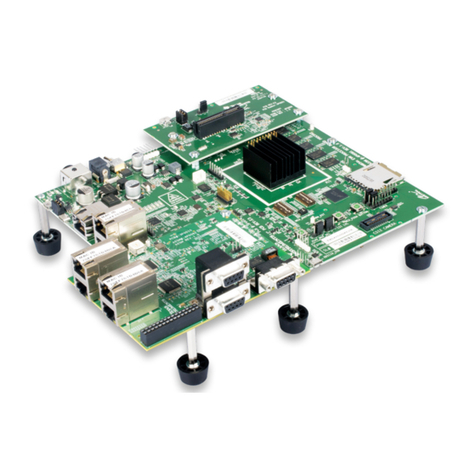
Texas Instruments
Texas Instruments TMDX654IDKEVM quick start guide
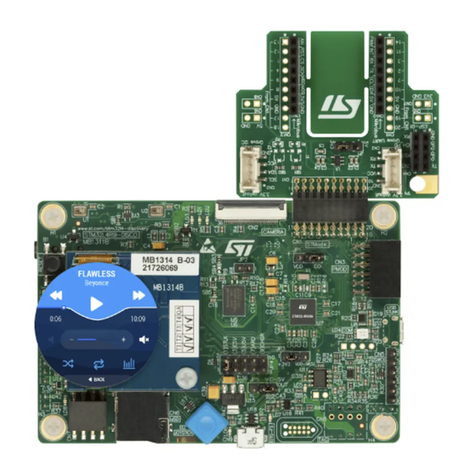
STMicroelectronics
STMicroelectronics 32L4R9IDISCOVERY user manual
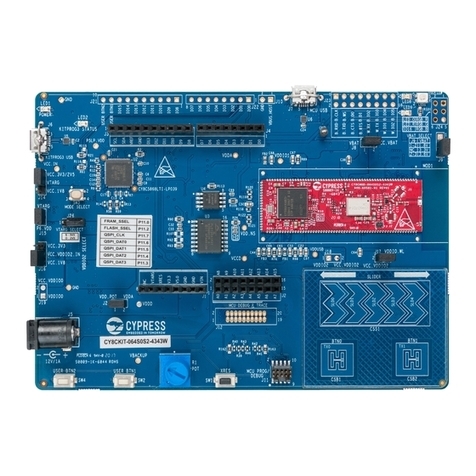
Infineon
Infineon Cypress CY8CKIT-064S0S2-4343W Kit Guide
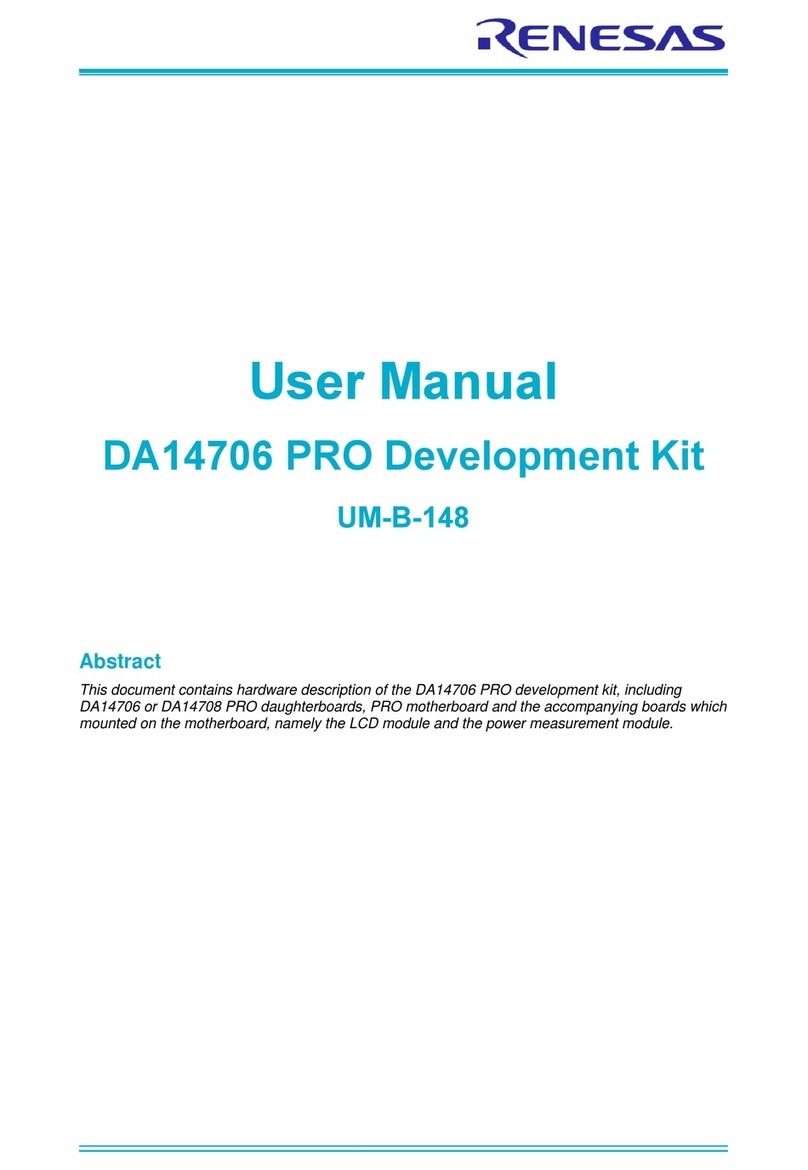
Renesas
Renesas DA14706 PRO user manual
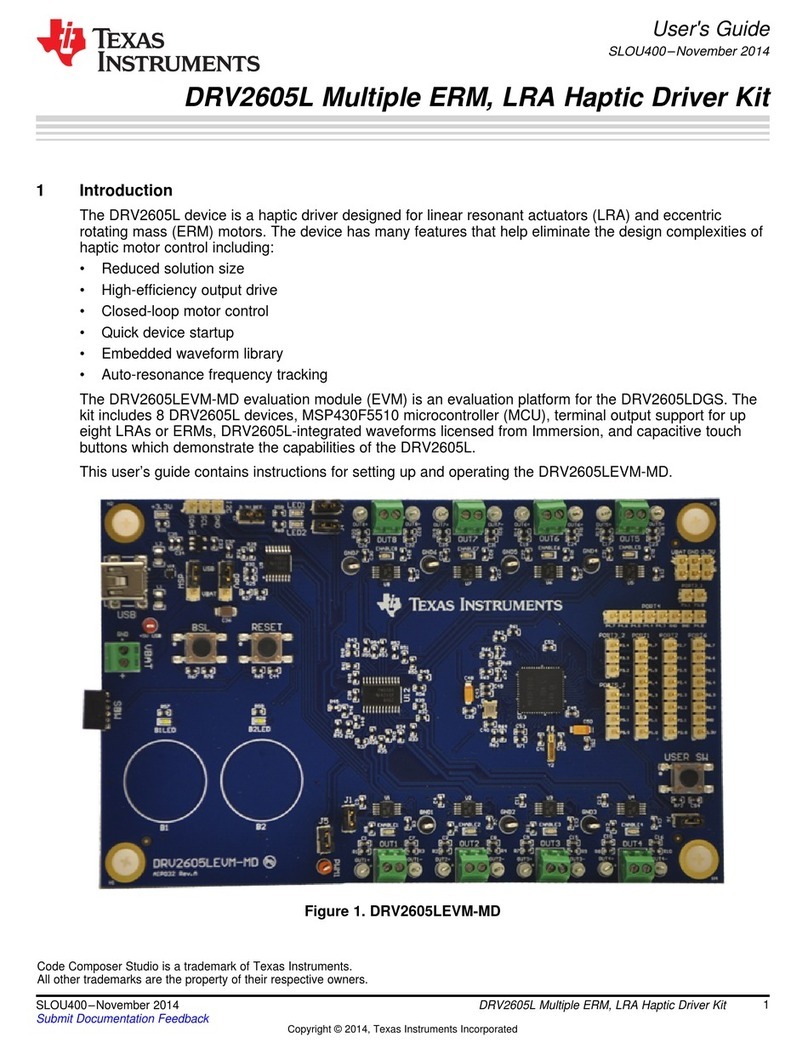
Texas Instruments
Texas Instruments DRV2605L user guide
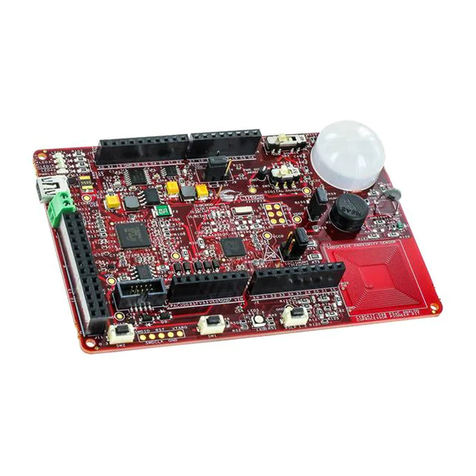
Cypress
Cypress PSoC CY8CKIT-048 quick start guide
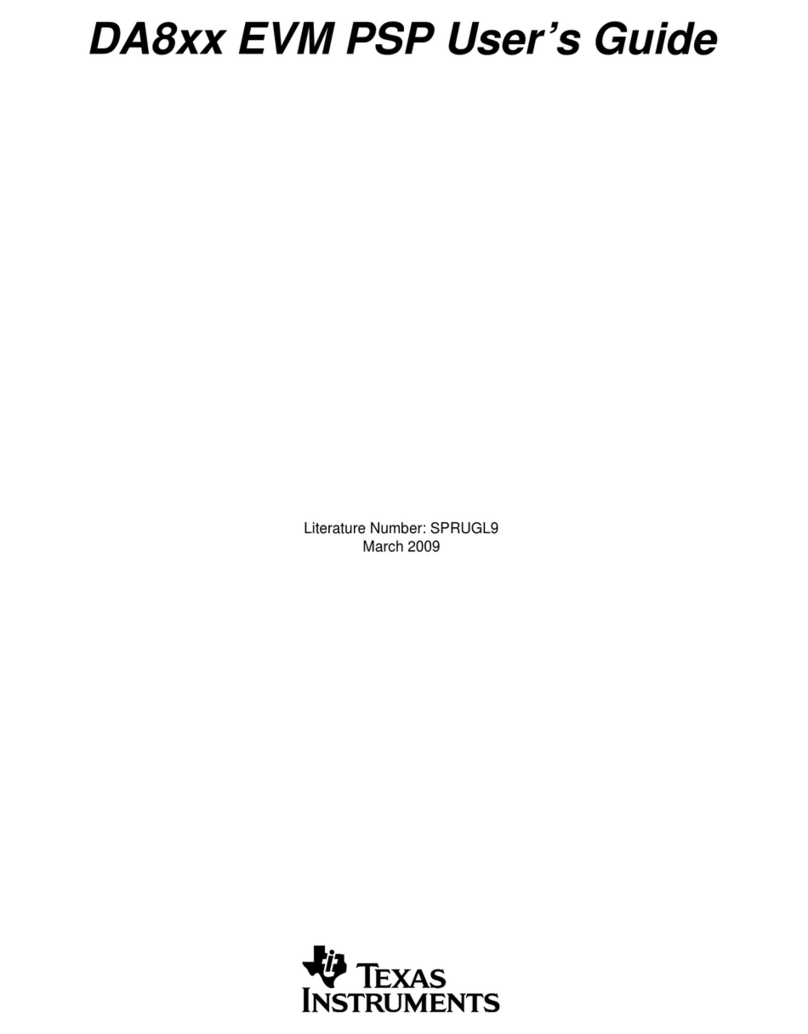
Texas Instruments
Texas Instruments DA8xx EVM PSP user guide
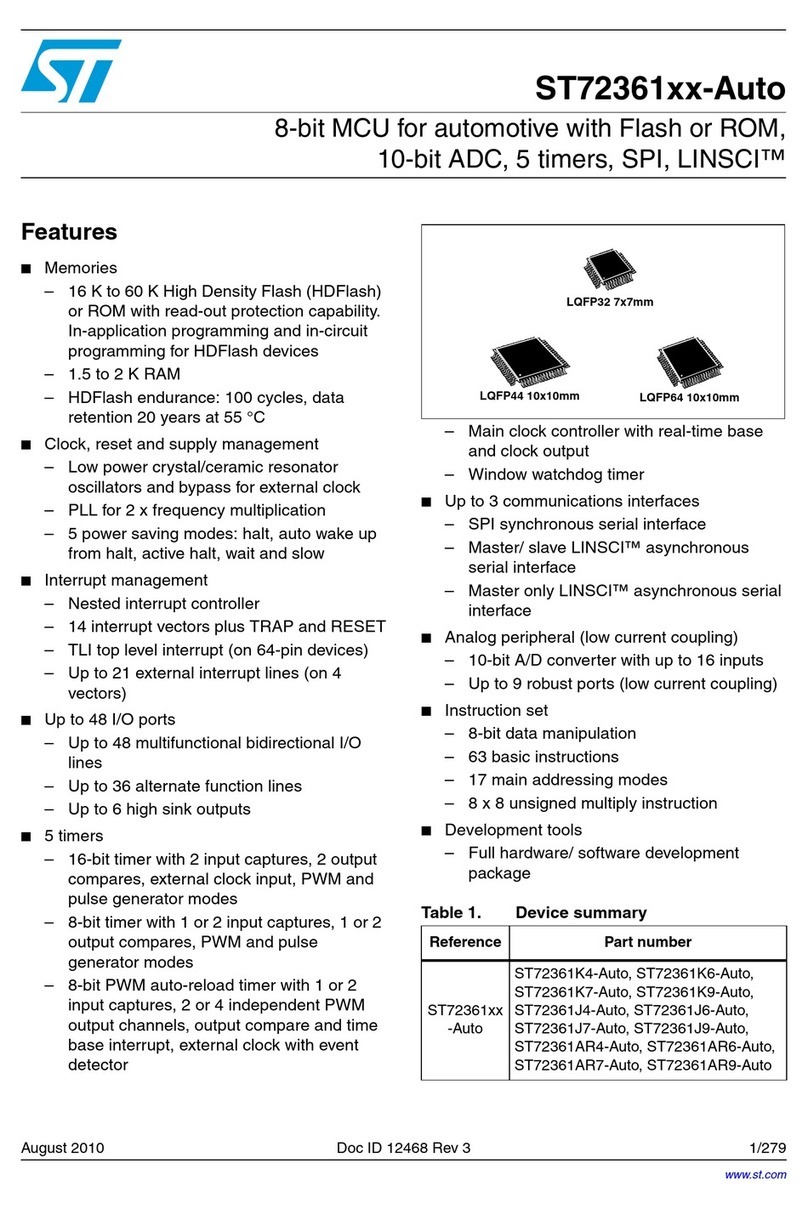
STMicroelectronics
STMicroelectronics ST72361 Auto Series manual

PLX Technology
PLX Technology PCI 9054RDK-860 Hardware reference manual
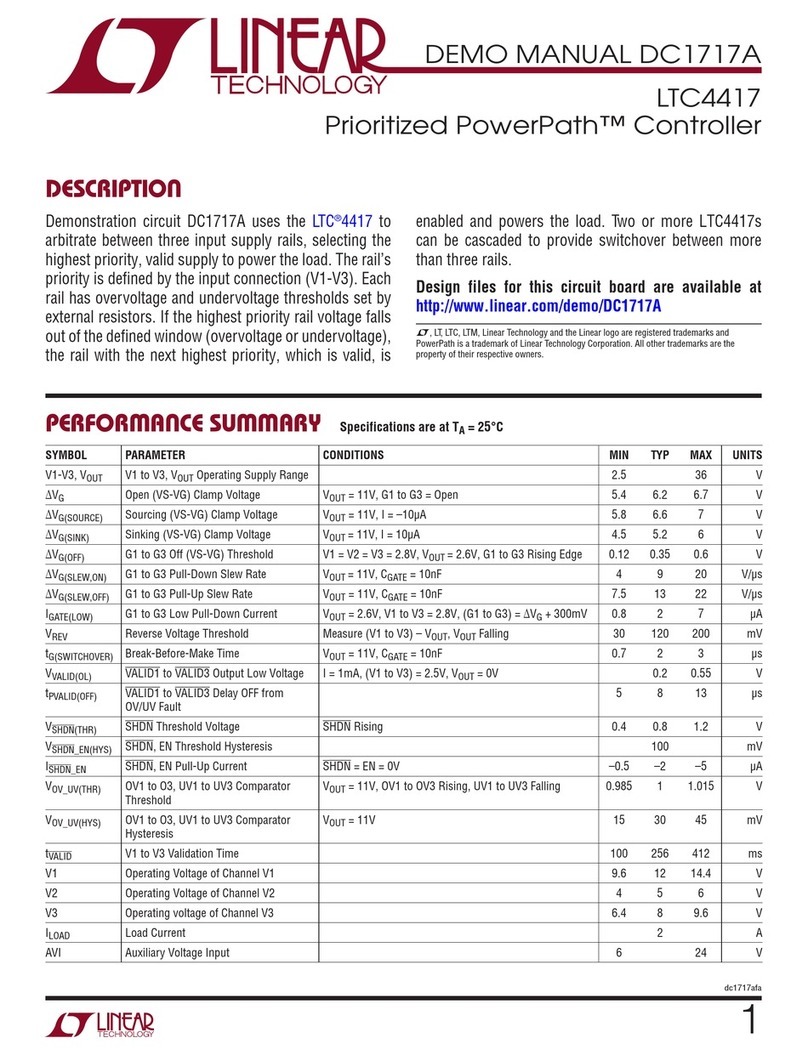
Linear
Linear DC1717A Demo Manual
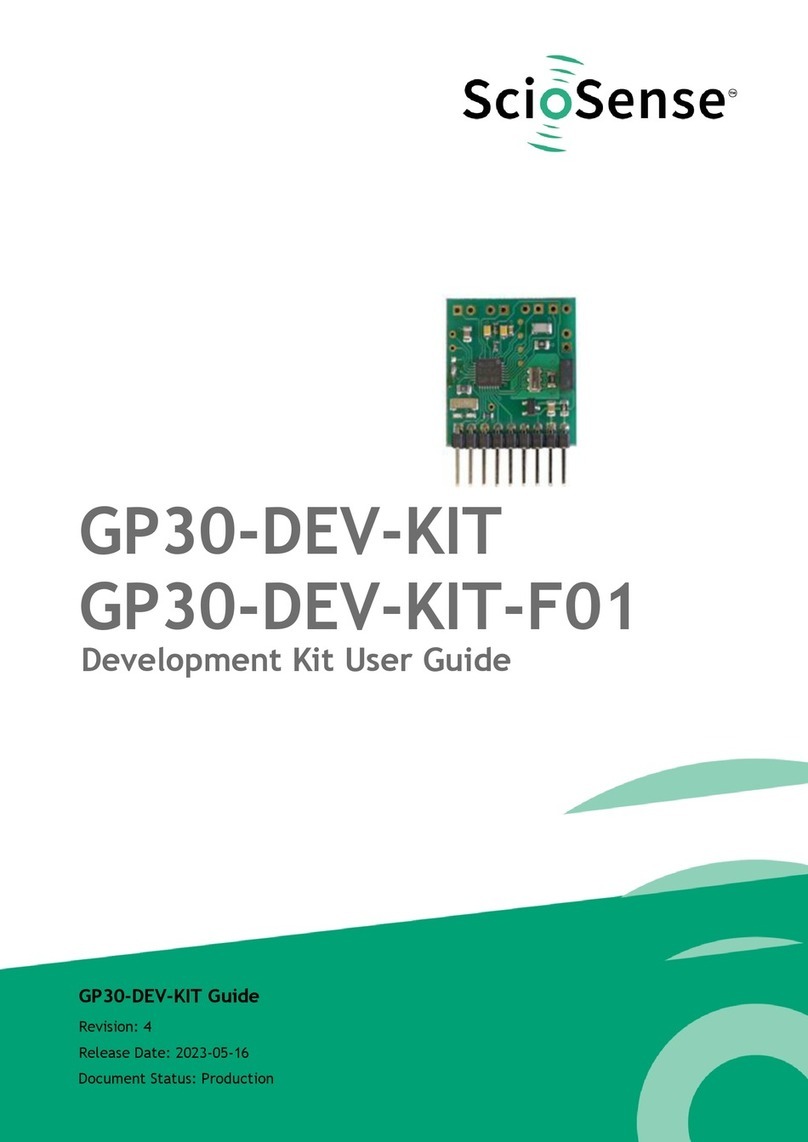
ScioSense
ScioSense GP30-DEV-KIT user guide
NXP Semiconductors
NXP Semiconductors QN9080 quick start guide
